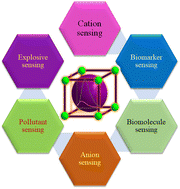Metal–organic framework (MOF)-based fluorescence “turn-on” sensors
Abstract
Metal–organic frameworks (MOFs) are a novel category of hybrid porous multifunctional materials with excellent qualitative features. These properties can be fine-tuned via the judicial choice of organic ligands and metal ions and by changing the synthetic reaction conditions. Among the various excellent applications exhibited by MOFs, the photoluminescence behaviour is very appealing and originates from their metal ions, linker, or entrapped guest molecules in their cavity. Thus, due to the tuneable luminescent properties of MOFs, they can act as sensors, enabling the selective and sensitive detection of a diverse range of analytes. In general, the sensing of analytes by MOFs can be accomplished either through a fluorescence “turn-on” (fluorescence intensity increases) or “turn-off” (fluorescence intensity decreases) process. Between them, the former is more important and significant in terms of real-time applications. This is because the “turn-on” emission occurs with the signal lighting (increases the fluorescence intensity) against a dark background. Therefore, this review summarizes the recent advances in MOFs as “turn-on” sensors for the recognition of a wide range of analytes (hazardous compounds, volatile organic molecules, cations, biomolecule, anions, etc.) and their sensing mechanism.

- This article is part of the themed collections: 2023 Materials Chemistry Frontiers Review-type Articles and Materials Chemistry Frontiers Most Popular Articles 2023


 Please wait while we load your content...
Please wait while we load your content...